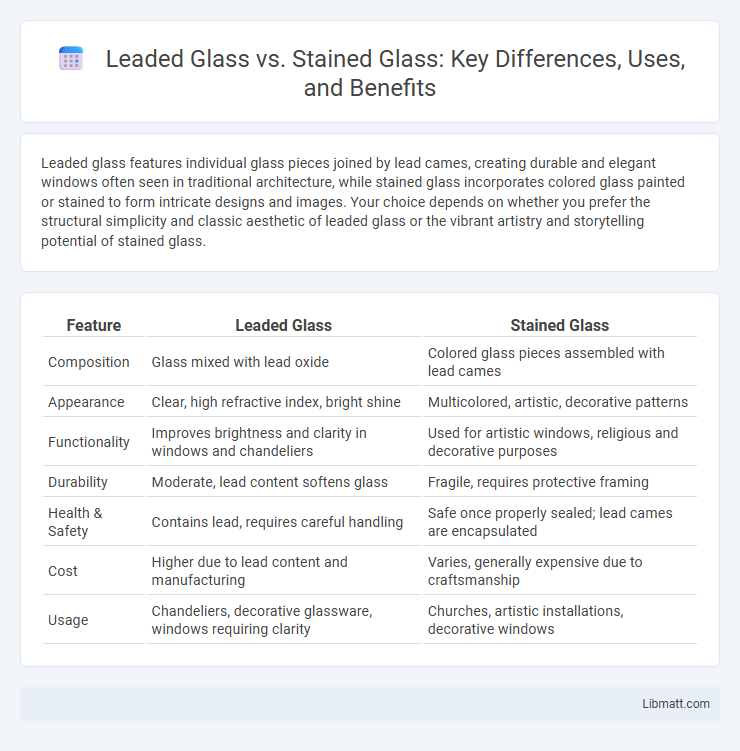Leaded glass features individual glass pieces joined by lead cames, creating durable and elegant windows often seen in traditional architecture, while stained glass incorporates colored glass painted or stained to form intricate designs and images. Your choice depends on whether you prefer the structural simplicity and classic aesthetic of leaded glass or the vibrant artistry and storytelling potential of stained glass.
Table of Comparison
| Feature | Leaded Glass | Stained Glass |
|---|---|---|
| Composition | Glass mixed with lead oxide | Colored glass pieces assembled with lead cames |
| Appearance | Clear, high refractive index, bright shine | Multicolored, artistic, decorative patterns |
| Functionality | Improves brightness and clarity in windows and chandeliers | Used for artistic windows, religious and decorative purposes |
| Durability | Moderate, lead content softens glass | Fragile, requires protective framing |
| Health & Safety | Contains lead, requires careful handling | Safe once properly sealed; lead cames are encapsulated |
| Cost | Higher due to lead content and manufacturing | Varies, generally expensive due to craftsmanship |
| Usage | Chandeliers, decorative glassware, windows requiring clarity | Churches, artistic installations, decorative windows |
Introduction to Leaded Glass and Stained Glass
Leaded glass consists of individual glass pieces joined by lead cames, creating geometric patterns often used in windows and decorative panels. Stained glass involves coloring glass with metallic salts during its manufacture, producing vibrant hues that form intricate images or designs. Your choice between leaded and stained glass impacts both the aesthetic and function of architectural projects, as each technique offers distinct visual effects and craftsmanship methods.
Historical Background of Each Glass Type
Leaded glass, originating in the medieval period, was primarily used in Gothic cathedrals, where small glass pieces were joined by lead cames to create sturdy windows. Stained glass, also dating back to the Middle Ages, evolved as a form of artistic expression featuring vividly colored glass painted with detailed scenes, often depicting religious themes in churches. Understanding these historical backgrounds helps you appreciate the craftsmanship and cultural significance behind each glass type.
Materials and Composition Differences
Leaded glass consists of glass pieces joined by strips of lead came, creating a uniform, often clear surface with structural support. Stained glass incorporates colored glass pigments or painted details fused during firing, producing vibrant designs with varying textures. Your choice depends on whether you prefer the subtle elegance of leaded glass or the artistic expression offered by stained glass's intricate coloration.
Manufacturing Processes Compared
Leaded glass manufacturing involves joining multiple glass pieces with lead cames, creating a framework that supports intricate designs and structural integrity often found in windows and decorative panels. Stained glass production focuses on coloring glass sheets by adding metallic salts during melting or painting with vitreous paint, followed by kiln firing to permanently fuse colors, enabling vibrant and detailed imagery. When choosing your glass art, consider that leaded glass emphasizes assembly techniques, while stained glass highlights color application and firing methods.
Aesthetic Qualities and Visual Appeal
Leaded glass features intricate designs formed by joining pieces of clear or textured glass with lead cames, creating a sleek and geometric aesthetic that enhances light transmission and adds subtle elegance. Stained glass is characterized by vibrant, richly colored glass segments painted or fused with detailed imagery, producing dramatic visual storytelling and dynamic light patterns when illuminated. The choice between leaded and stained glass hinges on desired aesthetic impact: leaded glass offers refined clarity and structure, while stained glass delivers bold color and artistic expression.
Structural Strength and Durability
Leaded glass features individual glass pieces held together by slender lead cames, offering moderate structural strength but increased flexibility, which can be prone to bending or sagging over time. Stained glass often incorporates reinforced support bars or copper foil techniques, enhancing its durability and resistance to environmental stress. Your choice depends on whether you prioritize the traditional aesthetic of leaded glass or the reinforced longevity provided by stained glass construction methods.
Applications in Architecture and Design
Leaded glass is commonly used in architectural elements such as windows, doors, and decorative panels, providing structural support while allowing intricate geometric designs. Stained glass enhances interior spaces through vibrant color and artistic imagery, often featured in churches, public buildings, and custom residential installations. Your choice between leaded and stained glass depends on whether you prioritize durability and design versatility or vivid, narrative visual impact in architectural settings.
Maintenance and Restoration Challenges
Leaded glass requires careful cleaning with gentle, non-abrasive materials to prevent damage to the lead cames and glass surface. Stained glass restoration often involves complex techniques to repair painted details and re-lead panels, demanding skilled artisans for accurate preservation. Your choice between leaded and stained glass affects ongoing maintenance costs and restoration complexity, as stained glass typically necessitates more specialized care.
Cost Considerations and Value
Leaded glass typically offers a lower upfront cost compared to stained glass due to simpler production methods and fewer color variations. Stained glass, requiring intricate craftsmanship and multiple colored pieces, tends to have a higher price but adds significant artistic and historical value to your property. Choosing between leaded and stained glass depends on balancing budget constraints with the desire for a unique, visually striking investment.
Choosing Between Leaded and Stained Glass
Choosing between leaded and stained glass depends on the desired aesthetic and functional priorities. Leaded glass features clear or lightly textured panes held together by lead cames, offering a sleek, geometric look ideal for modern or minimalist designs. Stained glass incorporates vibrant colors and intricate painted details fused within the glass, creating elaborate artistic scenes suitable for decorative windows and historic restorations.
leaded glass vs stained glass Infographic

 libmatt.com
libmatt.com